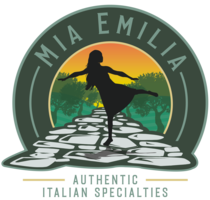Have you ever heard of soffritto? The word means slow fried, or under fried and indicates the cooking method for the first ingredients of a delicious red sauce. Ingredients to this can vary a bit, but typically in Italy the soffritto consists of three vegetables: onion, carrot, and celery.
They are chopped very finely, so once they are cooked down, they almost dissolve into the sauce. These three ingredients are chosen for their aromatic qualities.
Use a high-quality extra virgin olive oil and fry the onion, carrot, and celery until the little pieces of onion become transparent and all the vegetables have softened, about five minutes. You can include some dried herbs if you like as well.
The smell in your kitchen is divine as these ingredients simmer away in the oil. You can add a little bit of white wine if you want to enhance the flavor and cook for another couple of minutes to let the flavor absorb, and the alcohol evaporate.
Then, you are ready to add you tomatoes and any other ingredients for the red sauce you have in mind.
I must admit, I am not an onion fan. Usually I avoid them like the plague but having watched many Italian chefs making their favorite recipes, there was one thing most had in common. Soffritto. I gave in, and even I agree that it makes the perfect base for a sauce. To me, the secret is very tiny pieces.
So often in our “Italian” chain restaurants here in the US, pastas are served swimming in greasy sauce. It gives us the impression that Italian food is actually like that. Through the years of traveling to Italy it has been such fun to see those expectations demolished and the delight in faces discovering true Italian cuisine for the first time.
The difference between pasta “marinara” in one of those chain restaurants and the simple pasta pomodoro in Italy is life-changing! How the simplest of ingredients shine when they are lovingly grown and traditionally prepared!
Among my biggest surprises in Italy was my very first meal there, and it was at a gas station, though even the gas stations in Italy are fabulous. The bus pulled up to the Autogrill, and our guide was so excited for us to have lunch there. We were all thinking, “You’re kidding right? Our first lunch in Italy and you’re taking us to a gas station?”
We soon understood her excitement as we found the cafeteria style dishes to be amazingly fresh looking. The dining room was packed with businesspeople in suits, all Italians except for us.
I ordered the simplest, least adventurous pasta they had, at that time not understanding a word of Italian except for, “Ciao bella” and “Grazie”. Pasta pomodoro looked safe enough. My hopes were not high. They should have been. Even the color of the sauce was different from anything I’ve found here in the states. It was the color of a real tomato. The flavor was so fresh, so delicious. Not the slightest bit greasy.
If even a gas station meal could delight, we were all suddenly very excited about the rest that was to come. Years later, I have learned that the soffritto is a key to success in many of these authentic Italian sauces, and that the quality of the ingredients from Olive Oil to Pasta noodles truly makes the difference.
If you would like some inspiration, enjoy this simple and delicious recipe from the makers of some of Mia Emilia’s Pasta!
One Box of Mia Emilia’s La Pasta di Aldo Farrini Pasta
½ of an onion
1 stalk of celery
1 carrot
2 tablespoons of chopped Italian parsley
½ glass of white wine
80 grams of extra virgin olive oil
500 grams of peeled tomatoes
Salt and pepper to taste
In the pan, fry the finely chopped onion, celery, and carrot with a little bit of parsley. As soon as they turn golden brown (about five minutes) add the white wine and let cook for another couple of minutes. Add the tomatoes (crushed or blended). Add the salt and pepper to taste. Slow simmer to complete the cooking process, and then combine the cooked pasta in the sauce.

